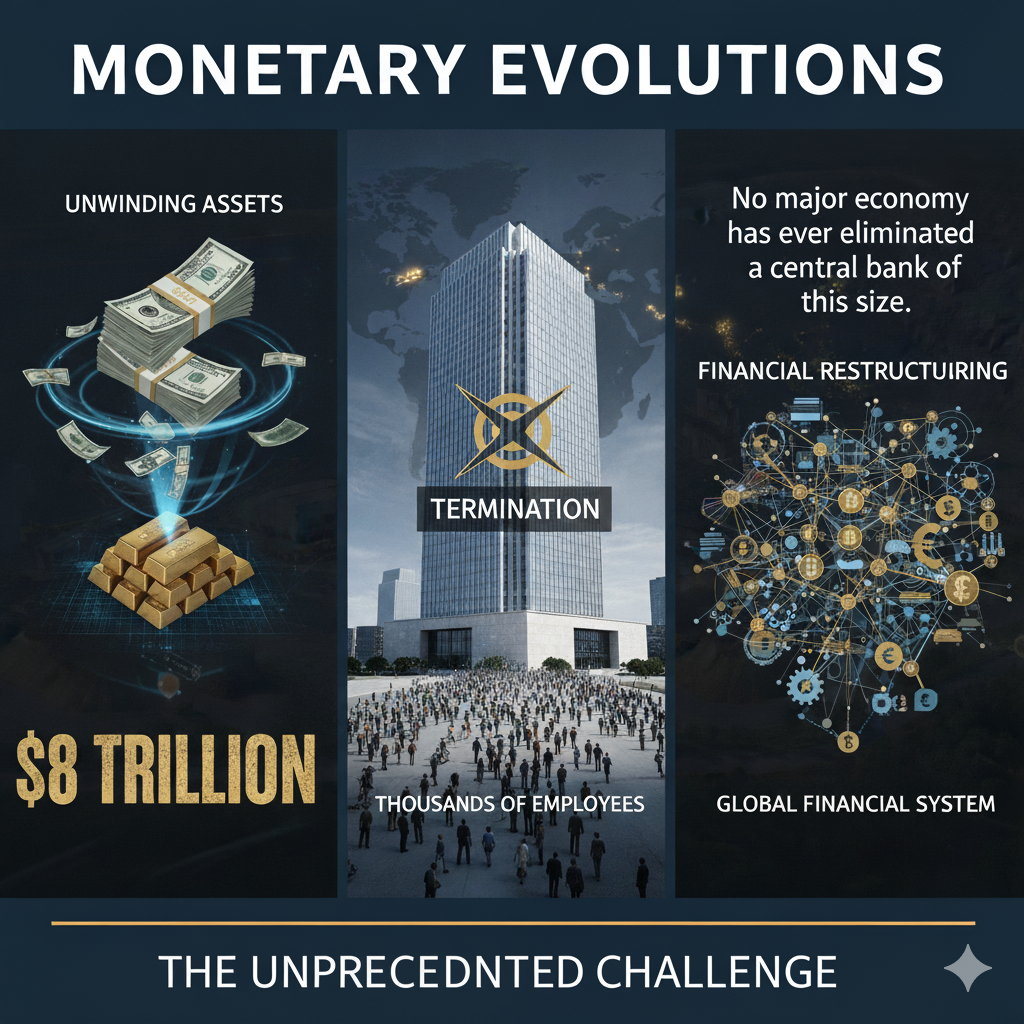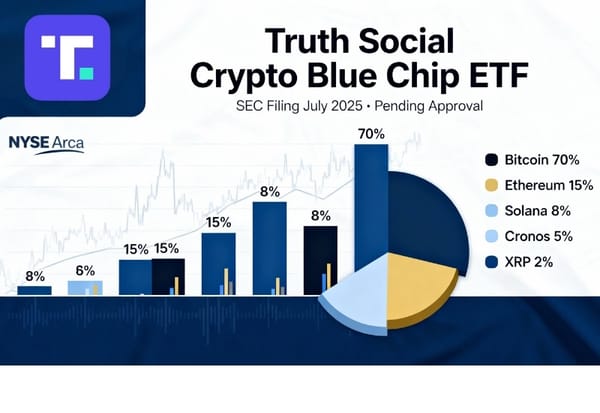Part III: Transition Scenarios and Federal Reserve Elimination Implementation
Eliminating the Federal Reserve requires unwinding $8 trillion in assets, terminating thousands of employees, and restructuring the entire financial system. No major economy has ever eliminated a central bank of the Fed's size and international importance.

The Most Complex Institutional Transformation in American History
Key Insight: Eliminating the Federal Reserve requires the most complex institutional transformation in American history, involving the unwinding of $8 trillion in Fed assets, termination of thousands of employees, and restructuring of the entire financial regulatory framework while simultaneously implementing precious metals standards.
The Federal Reserve elimination adds unprecedented complexity to precious metals transition scenarios. No major economy has ever eliminated a central bank of the Fed's size and international importance, making this analysis the first comprehensive examination of implementation strategies and market implications.
Constitutional and Legal Framework for Fed Elimination
Congressional Authority and Implementation Process
Constitutional Basis: The Federal Reserve Act of 1913 was congressional legislation that can be repealed through the normal legislative process [1].
Legal Requirements:
- House and Senate passage of the Federal Reserve Elimination Act
- Presidential signature or congressional override of a potential veto
- Transition period specification (recommended 3-5 years for systematic unwinding)
- Asset transfer mechanisms for the Fed balance sheet and regional bank properties
Precedent: Andrew Jackson successfully eliminated the Second Bank of the United States in 1836, demonstrating the political feasibility of central bank elimination [2].
International Legal Complications
Fed International Obligations:
- $60 trillion in currency swaps with foreign central banks [3]
- International monetary cooperation agreements requiring Fed participation
- Bank for International Settlements membership and Basel Accord compliance
- IMF Special Drawing Rights denominated in Fed-created dollars
Resolution Mechanisms:
- Bilateral negotiations with foreign central banks for swap line termination
- Precious metals-based alternatives to international Fed obligations
- Congressional abrogation of international agreements requiring Fed participation
- State Department coordination of new international monetary relationships
Federal Reserve Balance Sheet Unwinding Scenarios
Current Fed Assets and Liabilities ($8.2 Trillion Total)
Asset Categories:
- U.S. Treasury Securities: $5.0 trillion (61% of total assets)
- Mortgage-Backed Securities: $2.4 trillion (29% of total assets)
- Federal Agency Debt: $0.5 trillion (6% of total assets)
- Other Assets: $0.3 trillion (4% of total assets) [4]
Liability Structure:
- Federal Reserve Notes: $2.3 trillion (28% of total liabilities)
- Bank Reserves: $3.2 trillion (39% of total liabilities)
- Reverse Repos: $2.1 trillion (26% of total liabilities)
- Treasury Account: $0.6 trillion (7% of total liabilities)
Scenario 1: Rapid Unwinding (12-24 months)
Emergency Implementation Strategy:
- Congressional emergency powers for accelerated Fed elimination
- Treasury absorption of Fed government securities to prevent market disruption
- Mortgage-backed securities auction to private markets with loss recognition
- Federal Reserve Note conversion to precious metals-backed currency at fixed exchange rate
Market Impact Projections:
- Government bond yields rise 300-500 basis points as Fed purchasing ends
- Mortgage markets face severe disruption as $2.4 trillion MBS hits private markets
- Banking system stress as $3.2 trillion in reserves converts to precious metals backing
- Currency volatility exceeding the 1971 Nixon Shock as the dollar system collapses
Emergency Stabilization Measures:
- Trading halts in government bond and mortgage markets during the transition
- Bank holiday declarations for reserve system conversion
- International capital controls to prevent currency runs
- Precious metals market closure during re-pegging operations
Scenario 2: Systematic Unwinding (3-5 years)
Phased Implementation Strategy:
Year 1: Preparation and Framework
- Federal Reserve Elimination Act passage with a detailed transition timeline
- Precious metals accumulation by the Treasury for new monetary backing
- Banking system preparation for transition to market-based reserves
- International negotiations for new monetary cooperation frameworks
Year 2-3: Asset Reduction and System Transition
- Fed balance sheet reduction of $2-3 trillion annually through asset sales and maturity rollovers
- Regional Fed bank privatization or conversion to clearinghouses
- Banking regulation transfer to state authorities and private mechanisms
- Partial precious metals backing introduction for new currency issuance
Year 4-5: Complete Transition
- Remaining Fed assets transferred to Treasury management or private markets
- Federal Reserve Note conversion to precious metals-backed currency
- New monetary institutions are operational for domestic and international coordination
- Fed employment transitioned to the private sector or was eliminated
Market Impact Management:
- Gradual interest rate normalization as Fed manipulation ends
- Systematic bank adaptation to market-based operations
- International monetary system evolution with American precious metals leadership
- Asset price adjustment over an extended period rather than a shock transition
Scenario 3: Crisis-Forced Elimination (6-18 months)
Crisis Triggers:
- Fed policy credibility loss through persistent inflation or financial system failure
- International dollar rejection by major trading partners and central banks
- Congressional emergency action due to an economic or political crisis
- Constitutional crisis over Fed independence and democratic accountability
Emergency Implementation:
- Fed operations suspension pending congressional action and system restructuring
- Emergency precious metals standard implementation to restore monetary credibility
- International cooperation for global monetary system stabilization
- Private sector coordination for emergency banking and payment systems
Extreme Market Volatility:
- Financial markets closure during the emergency transition period
- Currency markets chaos as dollar system collapses and new standards emerge
- International trade disruption requires emergency settlement mechanisms
- Banking system nationalization or emergency private coordination
Regional Federal Reserve Bank Elimination
Current Regional Fed Structure
Twelve Regional Banks:
- New York Fed: Most important due to international operations and primary dealer relationships
- San Francisco Fed: Largest geographic area covering Western states
- Chicago Fed: Agricultural and industrial Midwest focus
- Other Regional Banks: Philadelphia, Cleveland, Richmond, Atlanta, St. Louis, Minneapolis, Kansas City, Dallas, Boston [5]
Regional Bank Assets and Functions:
- Real estate holdings: Federal Reserve Bank buildings and operational facilities
- Gold and precious metals: Historical reserves stored in regional bank vaults
- Banking supervision: State bank examination and regulatory functions
- Economic research: Regional economic data and policy analysis
Privatization and Conversion Options
Conversion to Private Clearinghouses:
- Member bank ownership of former Fed regional banks
- Interbank settlement and coordination functions without government backing
- Emergency lending through mutual insurance rather than the Fed authority
- Regional economic research and coordination services for private banking
Asset Disposition Strategies:
- Real estate sales to private buyers or conversion to commercial use
- Gold and precious metals transfer to the new monetary authority or Treasury management
- Employee transition to private sector banking or government termination
- Intellectual property and research assets are transferred to universities or private institutions
Regional Economic Impact:
- Employment effects in Fed regional bank cities as thousands of jobs are eliminated or privatized
- Economic development changes as the regional Fed presence and spending disappear
- Banking center status adjustments as private banking replaces Fed regional coordination
Banking System Transformation During Fed Elimination
Current Fed-Dependent Banking Operations
Reserve Requirements: Banks hold excess reserves at Fed regional banks, earning the Fed-determined interest rates.
Fed Funds Market: Interbank lending coordinated through Fed systems and influenced by Fed policy.
Payment Systems: Fedwire and Fed payment systems handle $3-4 trillion daily in interbank transactions [6].
Regulatory Supervision: Fed examination and regulation of state-chartered banks and bank holding companies.
Post-Fed Banking System Architecture
Market-Based Reserve Management:
- Banks compete for deposits to fund lending operations rather than relying on Fed reserves
- Clearinghouse operations coordinate interbank settlements through private mechanisms
- Interest rates are determined by supply and demand for funds rather than Fed manipulation
- Reserve ratios are determined by market demand and competitive positioning
Payment System Privatization:
- Private payment networks replace Fed systems for interbank transactions
- Precious metals settlement mechanisms for the final clearing of large transactions
- Technology innovation in payment systems without Fed constraints and regulatory burden
- International payment systems coordination without Fed participation
Banking Supervision Decentralization:
- State banking authorities resume primary supervisory role for state-chartered institutions
- Private rating agencies and market mechanisms provide a bank safety assessment
- Depositor due diligence replaces government insurance and Fed backstop
- Bank failures are handled through private resolution rather than government intervention
Community Banking Renaissance
Competitive Advantages Under Market Banking:
- Local relationships become the primary competitive advantage over large banks' efficiency
- Conservative lending practices align with market discipline rather than Fed moral hazard
- Regional specialization in precious metals and local economic sectors
- Member-owned institutions (credit unions) gain an advantage over shareholder-owned banks
Business Model Transformation:
- Fee-based services for precious metals custody and verification
- Local investment banking for community business development and capital formation
- International correspondent banking for precious metals trade and foreign exchange
- Technology adoption for competitive advantage without Fed regulatory constraints
Government Financing Revolution
End of Fed Deficit Monetization
Current Fed Government Support:
- Fed purchases of $5 trillion in Treasury securities enable deficit financing without market discipline
- Interest rate suppression reduces government borrowing costs below market levels
- Quantitative easing provides emergency government financing during crisis periods
- International dollar demand sis upported by the Fed policy, enabling trade deficit financing
Post-Fed Government Fiscal Reality:
- Government spending is limited to taxation revenue and genuine market borrowing
- Interest payments on existing debt at market rates become a major budget constraint
- Deficit financing becomes expensive or impossible without Fed monetization
- Government programs face immediate fiscal reality rather than monetary financing
Federal Spending Adjustment Requirements
Mandatory Spending Constraints:
- Social Security and Medicare face a funding crisis without Fed's monetization capability
- Defense spending requires congressional appropriation and taxation rather than deficit financing
- Interest payments on $33 trillion national debt become unsustainable at market interest rates [7]
- Federal employment faces reduction due to fiscal constraints and program elimination
Revenue Enhancement Options:
- Tax increases to fund existing programs face political resistance and economic consequences
- Asset sales, including federal land and government enterprises, are to reduce the debt burden
- User fees for government services to reflect true costs rather than subsidization
- State and local responsibility for programs currently federally funded
State and Local Government Crisis
Federal Transfer Dependence:
- State and local governments receive $700 billion annually in federal transfers that become unsustainable without Fed financing [8]
- Municipal bond markets face a crisis as Fed support disappears and federal transfers decline
- Public employee pensions become unfunded as investment return assumptions prove unsustainable
- State fiscal crisis as revenue declines and federal support disappears
Adaptation Strategies:
- Tax increases at state and local levels to replace federal funding
- Program elimination and service reduction to match revenue constraints
- Public-private partnerships for essential services and infrastructure
- Interstate cooperation for shared services and cost reduction
Investment Implications:
- Avoid municipal bonds and state government securities due to fiscal unsustainability
- Private companies providing services previously government-supplied gain market opportunities
- Real estate in fiscally responsible jurisdictions gains premium value
- Migration patterns toward low-tax states with sustainable finances
Fed Employee and Infrastructure Transition
Current Federal Reserve Employment
Fed System Employment:
- Federal Reserve Board: 2,000 employees in Washington DC for policy and supervision
- Regional Fed Banks: 18,000 employees across twelve cities for operations and research
- Specialized Functions: Banking supervision, payment systems, economic research, international relations
- Contractor and Consulting: Thousands of additional private sector employees serving Fed operations [9]
Employee Transition Strategies
Private Sector Absorption:
- The banking industry is hiring former Fed supervisors and analysts for regulatory compliance and risk management
- Financial services companies are hiring the Fed economists and researchers for market analysis
- Technology companies are hiring the Fed payment systems specialists for private payment network development
- Consulting firms are hiring former Fed officials for advisory services to banks and governments
Government Transfer Options:
- The Treasury Department's absorption of the Fed's international and government debt management functions
- Banking regulators (OCC, FDIC) are hiring Fed bank supervisors for continued regulatory functions
- Other federal agencies are hiring Fed economists and analysts for economic research
- Early retirement packages for Fed employees near retirement eligibility
Geographic and Economic Impact:
- Regional Fed cities face economic impact from major employer elimination
- Real estate markets in Fed locations adjust to reduced employment and economic activity
- Local businesses serving Fed operations face customer loss and potential closure
- Universities and research institutions' potential hiring of former Fed researchers
Market Transition Mechanisms and Protocols
Trading System Adaptations
Government Bond Market Restructuring:
- Primary dealer system elimination as the Fed no longer coordinates government bond auctions
- Treasury auctions face genuine market pricing without Fed support and guaranteed demand
- Secondary markets adjust to higher volatility and wider spreads without Fed intervention
- International demand for Treasury securities declines without Fed reserve currency support
Investment-grade
- Investment-grade and high-yield markets face repricing without a Fed backstop and liquidity support
- Corporate financing shifts toward equity and precious metals-backed instruments
- Credit analysis becomes more important as the Fed policy disappears
- International corporate bonds gain market share as dollar instruments lose Fed support
Equity Market Structural Changes:
- Stock buyback programs decline as cheap Fed credit disappears
- Dividend yields rise to compete with higher interest rates and precious metals returns
- Growth stock valuations compress without Fed-enabled cheap capital
- Value investing gains an advantage as market fundamentals become more important than Fed policy
Payment System Evolution
Interbank Settlement Modernization:
- Private clearinghouses replace Fed payment systems for domestic transactions
- Precious metals settlement mechanisms for large-value transactions and international trade
- Technology innovation in payment processing without Fed regulatory constraints
- Cryptocurrency integration with precious metals backing for digital transactions
International Payment Transformation:
- SWIFT system adaptation to precious metals and multiple currency settlement
- Bilateral payment agreements between countries using precious metals or commodity baskets
- Private international payment networks are competing with government-dominated systems
- Trade finance revolution using precious metals backing rather than Fed dollar instruments
Crisis Management and Emergency Protocols
Market Stability During Transition
Circuit Breaker Mechanisms:
- Expanded trading halts during extreme volatility in government bond and currency markets
- Precious metals market coordination to prevent panic buying and price manipulation
- Banking system emergency protocols for reserve conversion and liquidity management
- International coordination for currency market stability during dollar system transition
Emergency Liquidity Provision:
- Private bank consortia provide emergency lending through mutual insurance rather than the Fed discount window
- Clearinghouse operations coordinate interbank liquidity during transition stress periods
- Precious metals reserves mobilized for emergency settlement and system stability
- International cooperation through bilateral central bank agreements rather than Fed swap lines
Political and Social Stability Considerations
Public Communication Strategy:
- Congressional leadership explaining the Fed elimination benefits and constitutional restoration
- Educational campaigns about precious metals standards and market-based banking
- Historical precedent emphasizes successful pre-Fed economic performance
- International examples of successful monetary transitions and central bank elimination
Interest Group Management:
- Banking industry adaptation support and transition assistance for market-based operations
- Government employee transition programs and private sector placement
- International diplomatic coordination to prevent economic warfare and competitive devaluations
- Academic and policy community engagement for intellectual support and research backing
Investment Strategy During Fed Elimination Transition
Pre-Elimination Positioning (0-12 months before announcement)
Maximum Leverage Opportunities:
- Precious metals mining companies (40-50% of portfolio for aggressive investors)
- Physical precious metals (20-30% for all risk profiles)
- Community banks and credit unions (10-15% for Fed elimination beneficiaries)
- International precious metals exposure (10-20% for currency diversification)
Defensive Positioning:
- Minimize government bond exposure (0-5% maximum for all risk profiles)
- Reduce Fed-dependent bank holdings (avoid money center banks entirely)
- International diversification (25-40% in stable precious metals jurisdictions)
- Cash reserves (15-25% for opportunity capture during volatility)
During the Elimination Process (Announcement through implementation)
Volatility Management:
- Systematic rebalancing at predetermined volatility thresholds (VIX >50, precious metals volatility >40%)
- Profit-taking protocols in mining stocks during extreme appreciation phases
- Opportunity purchasing during panic selling in quality companies, adapting to a new system
- Liquidity preservation for emergency needs and transition period uncertainty
Sector Rotation Timing:
- Early phase (0-6 months): Maximum precious metals exposure and Fed elimination beneficiaries
- Middle phase (6-18 months): Begin adding companies adapting successfully to market-based systems
- Late phase (18+ months): Optimize portfolio for new equilibrium under precious metals standards
Post-Elimination Optimization (New system operational)
Long-term Portfolio Architecture:
- Precious metals core (20-30% permanent allocation)
- Productive companies adapted to sound money systems (40-50%)
- International diversification across precious metals currencies (20-30%)
- Real assets and productive property (10-20%)
New Investment Paradigms:
- Value investing dominance as Fed manipulation disappears
- Dividend focus as income becomes attractive relative to speculation
- Long-term orientation as stable money enables genuine planning
- Operational excellence becomes the primary competitive advantage
Legal and Regulatory Framework Transformation
Financial Regulation Without Fed
Banking Supervision Transition:
- State banking authorities resume primary regulatory role for state-chartered banks
- Office of the Comptroller of the Currency continues national bank supervision without Fed coordination
- FDIC functions adapt to market-based banking or face elimination
- Private rating agencies and market mechanisms provide a bank safety assessment
Securities Regulation Adaptation:
- SEC operations are independent of Fed monetary policy coordination
- Market manipulation enforcement enhancements without Fed intervention are confusing price discovery
- International securities regulation coordination without Fed participation
- Precious metals securities markets development and regulation
Insurance and Pension Regulation:
- State insurance regulation is unaffected by the Fed's elimination but impacted by interest rate normalization
- Pension fund regulation adaptation to higher interest rates and precious metals investment options
- Life insurance company regulation adaptation to the new investment environment
Congressional Monetary Authority Restoration
the federal
- Article I, Section 8 powers return to Congress from the federal delegation
- Precious metals standards establishment through congressional legislation
- Weights and measures standardization for precious metals and international trade
- Counterfeiting and fraud prevention in precious metals and currency systems
New Legislative Framework:
- Precious Metals Monetary Standards Act establishes gold and silver as constitutional money
- Free Banking Authorization Act permitted competitive banking without a federal central bank
- International Monetary Cooperation Act for precious metals trade and settlement agreements
- Government Fiscal Responsibility Act eliminates deficit monetization and requiring balanced budgets
Technology and Infrastructure Requirements
Digital Infrastructure for Precious Metals Systems
Blockchain and Verification Technology:
- Distributed ledger systems for precious metals ownership and transaction verification
- Smart contracts for automatic settlement and delivery of precious metals transactions
- Digital custody solutions combining physical storage with technological verification
- International interoperability standards for cross-border precious metals transactions
Security and Anti-Fraud Measures:
- Advanced assaying technology for real-time precious metals verification
- Cybersecurity systems are protecting the precious metals digital infrastructure
- Anti-counterfeiting measures for physical precious metals and digital certificates
- International cooperation systems for precious metals crime prevention
Physical Infrastructure Development
Storage and Custody Facilities:
- Private vault expansion for increased precious metals holdings
- Transportation networks for secure precious metals movement
- Regional distribution centers for precious metals commerce
- International storage facilities for cross-border holdings
Mining and Processing Infrastructure:
- Mining equipment and technology for increased precious metals production
- Refining facilities for precious metals processing and standardization
- Quality control and certification systems for precious metals purity
- Environmental technology for sustainable precious metals extraction
International Cooperation and Competition
Bilateral Monetary Agreements
Precious Metals Trade Agreements:
- Bilateral treaties for precious metals settlement of international trade
- Mutual recognition of precious metals standards and verification systems
- Joint infrastructure development for cross-border precious metals transactions
- Dispute resolution mechanisms for international precious metals commerce
Central Bank Cooperation Replacement:
- Treasury-to-Treasury agreements replacing Fed-to-central bank relationships
- Private bank consortia for international settlement without central bank coordination
- Commodity trading organizations for precious metals and international commerce
- International law development for precious metals and monetary sovereignty
Competitive Currency Systems
Multiple Precious Metals Standards:
- Gold standard adoption by the United States and potential allies
- Silver standard development by other countries or regional blocs
- Platinum or palladium standards for specialized economic sectors
- Commodity basket currencies, including precious metals and other resources
Currency Competition Benefits:
- Market-driven adoption ofthe most efficient monetary systems
- Innovation incentives for improved precious metals technology
- Geographic specialization based on natural resource advantages
- Elimination of monopoly central bank control over international monetary systems
Implementation Timeline and Key Milestones
Phase 1: Legislative and Preparation (Months 1-12)
Congressional Action:
- Federal Reserve Elimination Act introduction and committee hearings
- Constitutional amendment consideration for monetary reform
- International treaty renegotiation for Fed obligations
- Transition timeline establishment and milestone definition
Market Preparation:
- Precious metals market infrastructure development
- Banking system preparation for market-based operations
- International cooperation agreements for monetary transition
- Emergency protocols development for crisis management
Phase 2: Implementation and Transition (Months 12-48)
Fed Operations Wind-down:
- Balance sheet reduction through asset sales and transfers
- Regional bank privatization or closure
- Employee transition and facility disposition
- Regulatory function transfer to the appropriate authorities
New System Establishment:
- Precious metals standard implementation
- Private banking system development
- International monetary cooperation mechanisms
- Market-based payment and settlement systems
Phase 3: Optimization and Stabilization (Months 48+)
System Maturation:
- Market mechanism optimization and efficiency improvement
- International integration with other precious metals systems
- Technology advancement in the precious metals infrastructure
- Legal framework refinement and dispute resolution
Long-term Benefits Realization:
- Economic growth acceleration under sound money
- Price stability and business cycle moderation
- International competitiveness through genuine productivity
- Constitutional government restoration and democratic accountability
Conclusion: Managing the Most Complex Transition in History
The elimination of the Federal Reserve while implementing precious metals standards represents the most complex institutional transformation in American economic history.
Key Success Factors:
- Constitutional and Legal Preparation: Congressional authority and legal framework must be established before implementation begins
- International Coordination: Foreign cooperation is essential to prevent economic warfare and competitive disruptions
- Systematic Implementation: A 3-5 year transition period allows market adaptation while preventing systemic collapse
- Private Sector Leadership: Market mechanisms and private institutions must replace Fed functions rather than alternative government agencies
- Technology Integration: Digital infrastructure is essential for modern precious metals systems and international cooperation
Investment Strategy Implications:
- Early positioning in Fed elimination beneficiaries could generate extraordinary returns
- Risk management is crucial during the unprecedented transition complexity
- International diversification is essential as the dollar system collapses and new currencies emerge
- Long-term perspective required as transition unfolds over multiple years
Historical Significance: Successful Fed elimination would restore constitutional government, eliminate systematic economic manipulation, and create the foundation for the most prosperous economic system in American history.
Sources and References
[1] Federal Reserve Act of 1913. Federal Reserve History. https://www.federalreservehistory.org/essays/federal-reserve-act
[2] Hammond, Bray. Banks and Politics in America from the Revolution to the Civil War. Princeton University Press, 1957.
[3] Federal Reserve Bank of New York. "Central Bank Liquidity Swaps." https://www.newyorkfed.org/markets/international-market-operations/central-bank-liquidity-swaps
[4] Federal Reserve System. "Statistical Release H.4.1." https://www.federalreserve.gov/releases/h41/
[5] Federal Reserve System. "Federal Reserve Districts and Banks." https://www.federalreserve.gov/aboutthefed/federal-reserve-districts-and-banks.htm
[6] Federal Reserve Bank of New York. "Fedwire Funds Service." https://www.newyorkfed.org/fedwire/
[7] U.S. Treasury. "Monthly Statement of the Public Debt." https://fiscaldata.treasury.gov/datasets/monthly-statement-public-debt/
[8] Congressional Budget Office. "Federal Grants to State and Local Governments." https://www.cbo.gov/publication/57170
[9] Federal Reserve System. "2023 Annual Report: Budget Review." https://www.federalreserve.gov/publications/annual-report/



